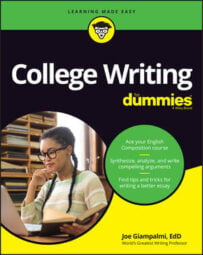Don't have time to read the entire article? Jump to the quick read summary.
 ©Peopleimages.com / Adobe Stock
©Peopleimages.com / Adobe StockNews flash. Your professor, a human being afflicted with a lifetime addiction to reading, determines your essay grade. As much as you’ve been told about the importance of writing for your audience, your professors are the one member of your audience you need to please. And because professors are sophisticated readers, they value writing that contains a skillfully created opening and closing.
Engaging openings and closings, the intersection of academic and professional writing, offer you the opportunity to impress your professor and stand out among your peers. When you undervalue the importance of an enticing opening and closing, you’re leaving points on the page. Here I focus on what you need to know about writing openings, including the first few sentences and the title.
To learn how to write an excellent closing to your essay, and about all other aspects of college writing, check out my book College Writing For Dummies.
Standing out
Let the gains begin. As a professor who read and graded tens of thousands of essays and research papers, I’m thrilled to see a thoughtful opening that interests me as a consumer of content. My grading experience tells me to anticipate an excellent grade and read the remainder of the essay to justify that grade.When you're thinking about how to start off an essay, remember that the purpose of your opening includes the following:
- Engage your reader in the topic and establish the organizational structure of your essay.
- Convince your reader of the importance of your topic and raise reader questions about the topic.
- Clarify your position on the topic question, using language from the assignment sheet.
- Highlight your overall essay plan.
- Demonstrate your command of language.
As you're thinking about how to start your essay introduction, avoid experimenting with a delayed thesis, such as positioning the thesis in the closing. Avoid this until you regularly write A-graded college essays.
When you read leisurely, focus on openings and closings that attract your attention. If you want to be nerdy about it, ask Siri to file them. And when you’re ready to write your openings and closings, consider re-engineering a favorite one you saved.While your opening provides background to place your topic within context, college essays usually require a background paragraph following the opening paragraph. Be sure all background content is related to the thesis, not merely to the topic.
Including an anecdote
Among the solid ways to start an essay is a go-to opening taught by many professors: the anecdote. It's brief personal experience story. You can use anecdotes in a wide variety of ways, such as:- Connect a different personal experience to each essay you’re assigned.
- Exercise your poetic license by writing an anecdote about an experience that happened to someone else.
- Write a fictional anecdote that appears believable if you’re feeling especially creative.
- Use one as a piece of evidence in the essay body. The more you use them, the better your skills at developing them.
- Use one as a style tool. Anecdotes are the gift that keep giving.
What to include in an anecdote
Anecdotes are scenes, not narratives with a beginning, middle, and ending. They range between five and six sentences within essays between 600 to 650 words. They aren’t the recount of an experience from beginning to end.Strategies for writing anecdotes include the following:
- Name relevant people, places, and events.
- Identify relevant time references.
- Consider a twist or surprise ending.
- Add brief dialogue when appropriate.
- Brainstorm your anecdote similar to how you brainstorm your essay.
- Reference conclusions from your anecdote that apply to your essay’s thesis.
Grabbing your reader’s attention
Similar to opening an essay, begin an anecdote with an attention-attracting first sentence. Following, are examples of language for beginning your anecdote and setting the scene:- When I visited Alaska, I experienced the highlight of my travel experience — walking on a glacier.
- I will never forget the desperation on animals' faces when I volunteered at the center for abused animals.
- Some of the most memorable lessons I learned in middle school occurred outside the classroom on camping trips.
- I hide emotions well, but holding tears failed me when I recognized the name on the post.
I boarded the helicopter from the heliport in Juneau, Alaska — aware that one crashed in recent weeks — anticipating the experience of flying above an ice field, landing on the Mendenhall Glacier, and walking across frozen tundra, thousands of years old. I walked to the edge of crevasses, looking down hundreds of feet at the flow of blue glacier water. I witnessed the excitement of one of nature’s unique performances. But on the helicopter flight back to Juneau, nature offered one additional surprise that changed my comfort level with nature’s majesty.
Using additional openings strategies
When you're thinking about how to start an introduction for an essay, consider these other opening strategies:- Series of questions: Many professors consider a one question opening a cliché strategy common to high school writing. But a series of questions raises the curiosity level and raises even more questions. Here’s a sample from my column reviewing Choke by Sian Beilock (Delco News Network): What’s the cause of high-performing students underperforming on a high-stakes standardized test such as the SAT and GRE (Graduate Record Examination)? What’s the cause of a professional athlete underperforming on a game-winning play or a pressure putt? Do underperforming students and athletes share common characteristics for their “choke”?
- What if? picture this: Another opening is the hypothetical “What if?” which raises questions and curiosities. Here’s a sample on a topic that interests you: What if colleges accepted more responsibility for ensuring graduation for the students they accept? What if their accountability included partial refunds of tuition and student loans for students who drop out? What if colleges fulfilled the promises to students and their parents made during freshmen orientation?
In addition to the previous opening strategies, openings also include the importance of the topic, the approach to the assignment, your position on the topic, and the thesis.
Steer clear of these types of openings
Here’s a look at openings as unappealing as a broken popsicle:- Previewing your intentions for the essay, such as what you plan to cover
- A dictionary or encyclopedia definition of the topic
- Restating the topic
- Presenting an overview of the topic
- An all-encompassing phrase such as: “Since the dawn of time …”
- Quotations that suddenly appear in text without context or follow up
Focusing on the first sentences
Are you surprised to hear that some professors will stereotype you as a student? Your professor’s assessment of your grade begins the first day of class with behaviors such as:- Arriving early and introducing yourself
- Sitting in the front row and assuming an academic position
- Actively participating in class discussions and taking notes
- Saying thank you on the way out of class
Unlike professional writers, inexperienced writers rarely prioritize first sentences and openings. Professional writers quickly learn that their most important sentence is the first because editors frequently buy or reject a piece of writing based on the reader connection of the first sentence. A lackluster title, first sentence, and opening won’t cost you money as a first-year student, but it can cost you a scoring opportunity.
Here’s a look at a few first-sentence strategies that will engage your reader, impress your professor, and score the grade (you can easily develop these first-sentence strategies into opening strategies):
- Surprise information: Readers enjoy a surprise. When the first-sentence surprise raises curiosity and questions, you have the ingredients for an engaging opening. Here’s a sample: Sleep researchers studying mice observed that the brain’s synapses, message connectors, surprisingly decrease about 20 percent after a few hours’ sleep. But they also discovered that the reduction makes you smarter. The second sentence (But they also …) shows a sentence that transitions into the thesis. Chapter 6 details more information about thesis statements.
- Expert quotations: Opening an essay with a quotation by an expert interests the most sophisticated readers, including your professor. Here’s an example: “Progress is made by trial and failure, the failures are generally a hundred times more numerous than the successes; yet they are usually left unchronicled,” said renowned chemist William Ramsey (1852–1916). Ramsey was referencing science, but his advice applies beyond science and into everyday life, including writing. The second sentence (Ramsey was referencing …) also shows a sentence that transitions into the thesis.
- Essential content connection: What is the most emotional part of your essay? For example, if your essay’s about the college dropout rate, play the emotional card by opening with a sentence describing what a college degree means to you and your family. Here’s a sample: I dreamed of my college graduation since my first day of school, but I didn’t dream of its financial and emotional toll on my family.
When your first sentence connects with your readers, you’re set up to deliver your second sentence and the remainder of your opening. Midway through your opening, your professor formulates a projection of your grade. Capitalize on the opportunity to impress your professor with a high-interest opening, and remember that good openings generate good grades.
Quick Read Summary
The essay is an essential component of college writing, much like books are to educated individuals and professors are to teaching. It has been a vital part of academia for over 15 centuries, and it's crucial to understand how to start an essay effectively.
Your professor, as a dedicated reader, plays a pivotal role in determining your essay's grade. They appreciate well-crafted openings and closings, which set your work apart. Neglecting the importance of a compelling start means missing out on valuable points.
An engaging opening serves multiple purposes: it draws in the reader, establishes the essay's structure, emphasizes the topic's significance, and clarifies your position while highlighting your overall essay plan. The opening guides the reader from the general topic to the specific thesis, a progression from the abstract to the concrete. Avoid experimenting with a delayed thesis placement until you're consistently writing high-quality essays.
An effective strategy for essay openings is the use of anecdotes, brief personal stories that connect to the topic. Anecdotes should be concise, involving relevant people, places, events, time references, and possibly a twist or surprise ending. They should tie back to the essay's thesis.
To captivate your reader, start with an attention-grabbing first sentence, such as an intriguing experience or a thought-provoking question. Other opening strategies include posing a series of questions or exploring hypothetical scenarios related to your topic.
Avoid unappealing openings, such as previews, dictionary definitions, restating the topic, or vague phrases like "Since the dawn of time." Professors often perceive these as lacking effort and thought.
In the academic world, first impressions matter. Your professor forms an initial impression of your work based on the essay's opening, particularly the first sentence. To engage your reader and secure a good grade, consider strategies like surprising information, expert quotations, or connecting with essential emotional content.
In summary, mastering the art of essay openings is crucial for academic success. Impress your professor with a well-crafted start, as it can significantly impact your grade.
Hungry for more? Go back and read the article or check out the book.

